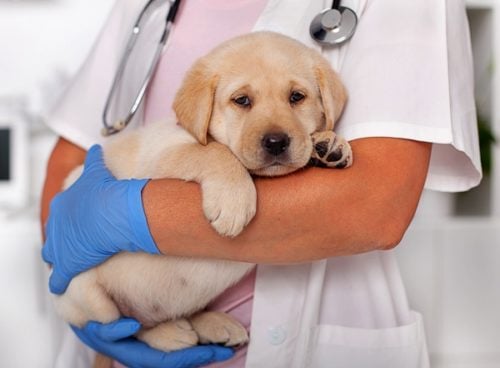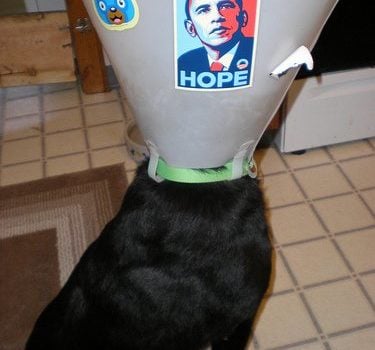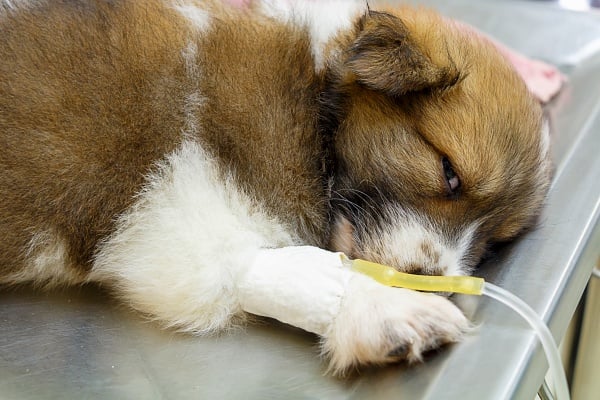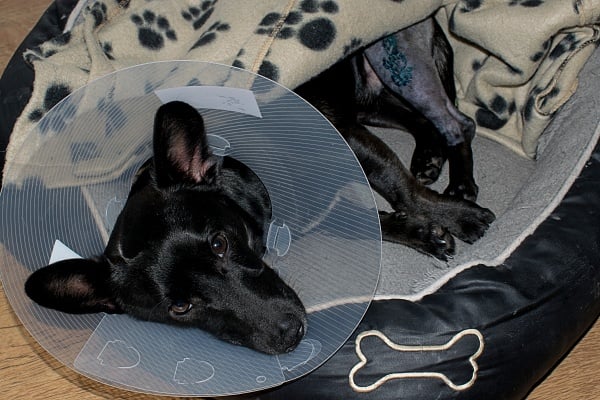Surgery is stressful for any pet and you the owner regardless if it is a relatively safe spaying or neuter surgery or something more serious. To care for your dog post – surgery, there are a few concerning things that may come up.
In this article, you’ll learn how to care for dogs after a surgical procedure, why your dog is shaking, how to help them rest, keep them warm, what to expect, and how to care for your dog after surgery. Please, call your veterinarian if you have any questions or concerns.

Table of Contents
How do I care for my dog after surgery?
One big tip to care for your dog after surgery is to keep them away from the surgery site. This usually means using an Elizabethan collar aka the “cone of shame”. This will prevent them from licking the site potentially loosening the stitches and causing an infection. As it’s likely new to them, they may bump the cone into walls and doorways (our biggest dog scraped some paint off the wall with his). You will have to remove if your dog has trouble eating and drinking with it on.
Your veterinary surgeon will likely give you specific instructions to you after surgery. Sometimes, the message doesn’t get across given the stress you are going through. We see this very often at our vet clinic. Our pet parents, post – surgery have a difficult time focusing on anything other than the welfare of their four legged fur baby.

It’s understandable as their pet just got out of surgery. Their pet isn’t themselves and quite often we’d see pet owner’s just nods affirmatively to every instruction we give without actually hearing them. It’s normal. If you aren’t given instructions on paper, we tell our patients parents to take a video of our conversation with their phone. This is very helpful later when they try to recall what we told them.
Your dog will react differently depending on the type of surgery needed for their specific medical condition. If your dog was given general anesthesia, this means they were “put under”. It’s just like they are asleep and their entire body is numbed to what’s going on. This is common for spay and neuter surgery for example. If they needed something less invasive done, a local anesthesia will be given. This is where just the part of the body that needs the operation is numbed instead of the whole body. This would be something like repairing their leg or paw.
Why is my dog shaking after surgery?
Your dog is shaking or shivering after surgery because of the effects of anesthesia. General anesthesia can cause this and can also make your pet sleepy. The effects of from anesthesia will help reduce unnecessary pain for some period after surgery but will eventually wear off. When you bring your pet home, the hours after surgery are most important for their recovery. Shaking or shivering doesn’t mean your dog is cold. That said, make sure to check that the room’s temperature isn’t too cold or too hot from what they are used to.

Please understand that your dog might be under the effects of anesthesia for up to 24 hours post – surgery. This means they probably won’t normally react to things like they normally would. In nature, your dog wouldn’t let the world know they are in pain or not feeling themselves. This would indicate weakness. As such, your dog may act defensively, cower, or be clumsy. This is why you want to take additional care of your dog in the days after surgery.
How to help your dog rest after surgery?
Give your dog space and a quiet place to rest. Give the pain relievers and anti-anxiety medications as prescribed by your veterinarian. If your dog is crate trained or sleep in a dog house, put them in there. Make sure the floor of their crate or dog house is extra soft with an additional blanket on top of the pad.They’ll feel safe in there and can get the rest they need for a successful recovery. If you have other pets like we do, close the door. This will help your pet feel even safer and keep your others pets away. Crate rest will also reduce your dog’s physical activity like jumping and sudden stretching which will help with the recovery process. Only give your dog pain control medication from your veterinarian and do not give human medications unless specially prescribed by your veterinarian.
Don’t place your dog on a bed, couch or other surface off the ground because they might fall off. Make sure they have no access to the stairs. We recommend using a baby gate to restrict your dog’s movements. During the first day, your dog might try to walk around without their mind turned fully on. Their movement is in most cases, clumsy as your dog cannot predict and see obstacles as well as they could before because of the effects from anesthesia. Also, dogs after surgery will be given pain medications which can also make them less like themselves. This can contribute to their clusiness and sleepiness.
How do I keep my dog warm after surgery?

Your dog will need a lot of rest during the first day of the postoperative recovery period. Place him or her in a warm place. Make sure that it is not too hot nor too cold. General anesthesia makes it impossible for your dog to identify if their body temperature is too cold or too hot. And even if they sense it, they probably won’t have enough energy to move to someplace else. That is actually a good thing because your dog needs to limit their movements after surgery, not exert themselves by walking around.
Further, don’t place your dog next to a heater, heater vent, or in direct sunlight. Regularly check on your dog to make sure they aren’t too hot or too cold.
It’s critically important to make sure your dog is warm however. This is because more than 80% of dogs suffer from being too cold or hypothermia post – surgery. If you are concerned about your dog’s body temperature, you can take your dogs temperature.
My dog is not eating after surgery, what should i do?
Your dog not eating after surgery is normal. Your dog should start to eat normally after 24 hours. While following your vets postoperative care instructions, you can offer about 1/4th of the normal food and water to your dog. They may refuse it so it’s best to not not push them if this happens. While your dog fasted prior to surgery, the anesthesia may affect their hunger for a day or so. When your appears to be recovering, continue to offer small amounts of their regular food. If your dog’s appetite has not returned within 48 hours, please contact your vet as this may indicate an infection.
Water however, is essential. Your dog might not feel that they are thirsty, but during the postoperative period they should consume even more water than usual. Even a small amount by chewing on ice cubes helps. For example, one of our dogs wasn’t able to drink like they could before their neuter procedure. We gave our male dog some ice cubes which were his favorite to chew on after his neutering surgery. He happily chewed them which helped keep him hydrated.
When you let your dog drink, pour only a small amount of water in their bowl but do not leave your dog unattended while drinking. Because of the effects of the anesthesia, your dog could fall asleep head first in their bowl.
What if my dog hasn’t peed or pooped after surgery?
This is normal. This is because general anesthesia interrupts your pet’s normal body functions. They also haven’t eaten as they fasted the night before their surgery so their system is empty. Their bladder is usually expressed prior to surgery so they won’t have to pee either. Basically, they have nothing to pee or poop out. Usually they will have to urinate as they’ve been given intravenous fluid to keep them hydrated during the surgery. Your pet’s system should return to normal in the next day or so. If your dog hasn’t pooped and peed within 48 hours, please contact your veterinarian.
Why is my dog coughing after surgery?

Your dog may cough after surgery because they were intubated while under general anesthesia. That means they had a tube inserted down their throat to help them breathe. This can irritate their throat and vocal cords. A mild post surgical cough usually resolves itself after a few days. Offer your fur baby water to help soothe their throat. If this continues for more than a few days, talk to your veterinarian.
What should you do when your dog arrives home after surgery?
Wound care is an essential part of caring for a dog after surgery. The faster they heal and the shorter the postoperative period, means a lower risk of complications and infection.
Make sure the incision site is clean and not covered in pus and scabs. Clean your pets incision with antibacterial soap or hydrogen peroxide as directed by your veterinarian. Change the bandages regularly as directed. We can’t stress this more strongly. Please strictly follow the instructions of your vet.
Wounds may continue to bleed a small amount and may release colorless fluid. This is okay and does not require much attention. Just make sure to clean the area as needed.
However, if wounds are bleeding a lot or release white or yellowish fluid call your veterinary. Do not hesitate, even if you are not quite sure about the amount or color of the fluid. Why take chances? It is far better to get an answer early to make sure your dogs recovery goes smoothly. Rest assured, nothing will happen if you call your vet and find out there is nothing to worry about. We are much happier to hear from our patients early if there is a complication rather than trying to get on top of something that has been developing for some time.
Monitor your dog for signs of pain that aren’t responding to the medications. This can be whining, crying, unusual restlessness, and aggressiveness. Please know that your dog doesn’t understand what happened to them, they just know they are in pain. Their medication should help, but if it doesn’t, there may be another medical issue. Contact your veterinarian if they don’t feel better in a day or so.
Make sure your dog or any of your other pets do not lick the surgical incision. It may cause an infection, pull out sutures, and will surely extend your pets recovery period. If necessary, use a cone collar and bandages to wrap the surgical site.
What should I watch for after my dog’s surgery?
The 24 hour period after a surgical procedure is the most important part of your dogs recovery and can be challenging for both you and your dog. While spaying and neutering are the most common and safe procedures performed by your vet, there is always the possibility of issues arising. One key is to look for signs of infection. These can be ongoing bleeding or pus oozing from the incision site, increased redness or swelling, and the incision starts to smell bad. If you see any of these, please contact your veterinarian. Healthy dogs are put under anesthesia with no issues for a variety of procedures such as orthopedic surgeries, spaying, and neutering. If your older dog needed another procedure, there are even more things to watch for. In this case, definitely consult with your veterinarian and follow their directives closely.
Limit your dog’s activity during the postoperative period. Don’t take them for long walks. Do not allow them to run and jump as it could cause the opening of the incision.
As we said above the hardest part of the postoperative period is the first day and sometimes the second day after surgery. Your dog needs special care and much more attention than normal during these days. Maybe it’s not a bad idea to take a day or two off work to care and comfort your dog.
Summary
If you encounter ANY problems during the postoperative period, do not hesitate to call your veterinarian Even if your vet already instructed you how to care for your dog after the surgery, do not be afraid to call again. And make sure to bring them to their follow up appointments.
You have learned how to care for dogs after a surgical procedure, why your dog is shaking, how to help them rest, keep them warm, and how to care for your dog after surgery. Now that you know why your dog is shaking after surgery, you are prepared to take care of them. This will go a long way towards your pet dog’s swift and complete recovery so they can be healthy and happy again. And keeping your Pet happy is what we all want.
FAQ
Question: Why is my dog shaking after surgery?
Answer: Your dog may be shaking or shivering after surgery due to the effects of anesthesia, which can make them sleepy and cause temporary trembling.
Question: How do I help my dog rest after surgery?
Answer: Provide your dog with a quiet and comfortable space to rest, and follow your veterinarian’s instructions for pain relievers and anti-anxiety medications.
Question: How do I keep my dog warm after surgery?
Answer: Place your dog in a warm area, making sure it’s not too hot or too cold. Avoid placing them next to heaters or in direct sunlight.
Question: What should I do if my dog hasn’t peed or pooped after surgery?
Answer: It’s normal for dogs not to pee or poop immediately after surgery. If this continues beyond 48 hours, contact your veterinarian.
Question: Why is my dog coughing after surgery?
Answer: Your dog may be coughing after surgery due to irritation from being intubated while under general anesthesia. A mild post-surgical cough usually resolves on its own, but if it persists, consult your veterinarian.
Question: What should I watch for after my dog’s surgery?
Answer: During the 24-hour postoperative period, monitor your dog for signs of infection, limit their activity, and provide special care and attention. If any issues arise, contact your veterinarian immediately.
